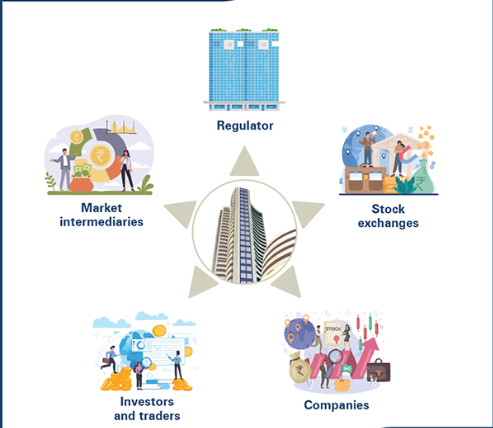Key Terms and Concepts in Stock Market Trading
Understanding the key terms and concepts in stock market trading is essential for anyone looking to navigate the complex world of financial markets. This comprehensive guide will delve into the different types of securities, market participants, and trading mechanisms, providing you with a solid foundation for making informed investment decisions.
Table of Contents
- Types of Securities
- Equity Securities (Stocks)
- Debt Securities (Bonds)
- Derivatives (Options, Futures)
- Hybrid Securities (Convertible Bonds)
- Other Investment Vehicles (Mutual Funds, ETFs)
- Market Participants
- Retail Investors
- Institutional Investors
- Market Makers
- Broker-Dealers
- Regulators
- Hedge Funds
- Proprietary Traders
- Trading Mechanisms
- Market Orders
- Limit Orders
- Stop Orders
- Short Selling
- Margin Trading
- High-Frequency Trading (HFT)
- Algorithmic Trading
1. Types of Securities
Equity Securities (Stocks)
Equity securities, commonly known as stocks, represent ownership in a company. When you purchase shares of a company, you become a shareholder and own a part of that company. Equity securities can be classified into common stocks and preferred stocks.
Common Stocks
- Voting Rights: Common shareholders typically have the right to vote on corporate matters, such as electing the board of directors.
- Dividends: They may receive dividends, which are a portion of the company’s profits distributed to shareholders.
- Capital Gains: Common stocks offer the potential for capital gains if the company’s stock price increases.
- Risks: Common shareholders are last in line to receive assets in the event of company liquidation, making these stocks riskier than bonds or preferred stocks.
Preferred Stocks
- Priority Dividends: Preferred shareholders receive dividends before common shareholders.
- Fixed Dividends: Dividends on preferred stocks are often fixed and do not fluctuate with the company’s earnings.
- No Voting Rights: Preferred shareholders typically do not have voting rights.
- Less Risk: In the event of liquidation, preferred shareholders have a higher claim on assets than common shareholders but are subordinate to debt holders.
Debt Securities (Bonds)
Debt securities are financial instruments that represent a loan made by an investor to a borrower, typically a corporation or government. Bonds are the most common type of debt securities.
Key Features of Bonds
- Principal: The amount of money borrowed, which the issuer agrees to repay at maturity.
- Coupon Rate: The interest rate paid by the bond issuer to the bondholders, usually expressed as an annual percentage of the principal.
- Maturity Date: The date on which the bond issuer must repay the principal to the bondholders.
- Credit Rating: An assessment of the bond issuer’s creditworthiness, which influences the interest rate and price of the bond.
Types of Bonds
- Corporate Bonds: Issued by corporations to raise capital for business activities.
- Government Bonds: Issued by governments to fund public projects and expenditures. Examples include Treasury bonds in the US and government securities in India.
- Municipal Bonds: Issued by local governments or municipalities to finance infrastructure projects.
- Convertible Bonds: Bonds that can be converted into a predetermined number of the issuing company’s shares.
Derivatives (Options, Futures)

Derivatives are financial instruments whose value is derived from an underlying asset, such as stocks, bonds, commodities, or currencies. The most common types of derivatives are options and futures.
Options
- Call Options: Give the holder the right, but not the obligation, to buy an asset at a specified price within a certain period.
- Put Options: Give the holder the right, but not the obligation, to sell an asset at a specified price within a certain period.
- Premium: The price paid for the option.
- Strike Price: The price at which the holder can buy or sell the underlying asset.
Futures
- Futures Contracts: Agreements to buy or sell an asset at a predetermined price on a specified future date.
- Standardized Contracts: Futures contracts are standardized in terms of quantity, quality, and delivery time.
- Margin Requirements: Investors must deposit an initial margin and maintain a maintenance margin to trade futures contracts.
Hybrid Securities (Convertible Bonds)
Hybrid securities combine features of both equity and debt instruments. Convertible bonds are a common type of hybrid security.
Convertible Bonds
- Conversion Feature: These bonds can be converted into a predetermined number of the issuing company’s shares.
- Interest Payments: Convertible bonds pay interest like regular bonds.
- Potential for Capital Gains: If the company’s stock price rises, the bonds can be converted into shares, offering potential capital gains.
- Lower Interest Rates: Convertible bonds usually offer lower interest rates than regular bonds due to the conversion feature.
Other Investment Vehicles (Mutual Funds, ETFs)
Mutual funds and exchange-traded funds (ETFs) are pooled investment vehicles that allow investors to diversify their portfolios by investing in a variety of assets.
Mutual Funds
- Open-End Funds: Investors can buy and sell shares of the fund at the net asset value (NAV) calculated at the end of each trading day.
- Diversification: Mutual funds invest in a diversified portfolio of stocks, bonds, or other assets.
- Active vs. Passive Management: Actively managed funds aim to outperform a benchmark index, while passively managed funds aim to replicate the performance of an index.
Exchange-Traded Funds (ETFs)
- Trading on Exchanges: ETFs trade on stock exchanges like individual stocks.
- Intraday Pricing: Investors can buy and sell ETF shares at market prices throughout the trading day.
- Lower Costs: ETFs generally have lower expense ratios than mutual funds.
- Tax Efficiency: ETFs are often more tax-efficient due to their unique creation and redemption process.

2. Market Participants
Understanding the different market participants is crucial for navigating the stock market effectively. Each participant plays a distinct role in the functioning of the market.
Retail Investors
Retail investors are individual investors who buy and sell securities for their personal accounts. They typically invest smaller amounts of capital compared to institutional investors.
Characteristics of Retail Investors
- Individual Accounts: Retail investors manage their own investment accounts.
- Varied Goals: Investment goals may include wealth accumulation, retirement planning, or saving for education.
- Limited Resources: Retail investors often have limited access to research and professional advice compared to institutional investors.
Institutional Investors
Institutional investors are organizations that pool large sums of money to invest in securities, real estate, and other assets. Examples include pension funds, mutual funds, insurance companies, and hedge funds.
Characteristics of Institutional Investors
- Large Capital: Institutional investors manage significant amounts of capital.
- Professional Management: Investments are managed by professional fund managers.
- Market Influence: Due to their large capital base, institutional investors can significantly influence market prices and trends.
Market Makers
Market makers are firms or individuals that provide liquidity to the market by buying and selling securities at quoted prices. They play a crucial role in ensuring smooth and efficient market operations.
Roles of Market Makers
- Bid-Ask Spread: Market makers quote both a buy (bid) price and a sell (ask) price for securities, profiting from the spread.
- Liquidity Provision: By continuously quoting prices, market makers facilitate trading and provide liquidity.
- Risk Management: Market makers manage the risk of holding inventory by hedging their positions.
Broker-Dealers
Broker-dealers are firms that buy and sell securities on behalf of their clients and for their own accounts. They act as intermediaries between buyers and sellers.
Functions of Broker-Dealers
- Execution Services: Broker-dealers execute buy and sell orders for clients.
- Advisory Services: Many broker-dealers offer investment advice and portfolio management services.
- Proprietary Trading: Broker-dealers may trade for their own accounts, aiming to profit from market movements.
Regulators
Regulators are government agencies or self-regulatory organizations (SROs) responsible for overseeing the securities markets and protecting investors. Examples include the Securities and Exchange Board of India (SEBI) and the Securities and Exchange Commission (SEC) in the United States.
Roles of Regulators
- Market Oversight: Regulators monitor market activities to ensure fairness and transparency.
- Investor Protection: They enforce rules and regulations to protect investors from fraud and market manipulation.
- Compliance: Regulators ensure that market participants comply with securities laws and regulations.
Hedge Funds
Hedge funds are private investment funds that employ various strategies to generate high returns for their investors. They are typically open only to accredited investors and institutions.
Characteristics of Hedge Funds
- Diverse Strategies: Hedge funds use a wide range of strategies, including long/short equity, event-driven, and global macro.
- Leverage: Many hedge funds use leverage to amplify returns, increasing both potential gains and risks.
- Performance Fees: Hedge fund managers often charge a performance fee based on the fund’s profits, in addition to a management fee.
Proprietary Traders
Proprietary traders trade financial instruments using a firm’s own capital, aiming to generate profits. These traders do not execute trades on behalf of clients.
Characteristics of Proprietary Traders
- Firm Capital: Proprietary traders use the firm’s capital for trading activities.
- Sophisticated Strategies: They employ advanced trading strategies, including arbitrage, algorithmic trading, and market making.
- High Risk and Reward: Proprietary trading involves significant risk but can also yield substantial profits.
3. Trading Mechanisms
Trading mechanisms refer to the various methods and processes used to buy and sell securities in the
stock market. Understanding these mechanisms is crucial for effective trading.
Market Orders
Market orders are instructions to buy or sell a security immediately at the best available price. They are executed as soon as possible, ensuring quick execution but not guaranteeing a specific price.
Characteristics of Market Orders
- Immediate Execution: Market orders are executed quickly, often within seconds.
- Price Uncertainty: The execution price may differ from the last quoted price, especially in volatile markets.
- High Liquidity: Market orders are suitable for highly liquid securities where price changes are minimal.
Limit Orders
Limit orders are instructions to buy or sell a security at a specified price or better. These orders provide price control but do not guarantee execution.
Characteristics of Limit Orders
- Price Control: Limit orders ensure that the trade is executed at the specified price or better.
- Execution Uncertainty: The order may not be executed if the market price does not reach the specified limit price.
- Strategic Use: Limit orders are useful for entering or exiting positions at desired price levels.
Stop Orders
Stop orders are instructions to buy or sell a security once it reaches a specified price, known as the stop price. They are used to limit losses or protect profits.
Types of Stop Orders
- Stop-Loss Orders: Sell orders placed below the current market price to limit potential losses.
- Stop-Buy Orders: Buy orders placed above the current market price to enter a position during a price breakout.
Characteristics of Stop Orders
- Automatic Execution: Stop orders are automatically triggered once the stop price is reached.
- Risk Management: They help manage risk by providing predefined exit points.
- Market or Limit: Stop orders can be combined with market or limit orders for execution.
Short Selling
Short selling involves selling securities not currently owned, with the expectation that their price will decline. The seller aims to buy back the securities at a lower price to make a profit.
Characteristics of Short Selling
- Borrowing Securities: Short sellers borrow securities from a broker to sell in the market.
- Profit from Decline: The goal is to profit from a decline in the security’s price.
- Unlimited Risk: Potential losses are unlimited if the security’s price rises instead of falling.
- Margin Requirements: Short selling typically requires a margin account and meeting specific margin requirements.
Margin Trading
Margin trading involves borrowing funds from a broker to buy securities, amplifying both potential gains and losses. It allows traders to leverage their positions but comes with higher risk.
Characteristics of Margin Trading
- Leverage: Margin trading increases the buying power of traders by allowing them to purchase more securities than they could with their own funds.
- Interest Costs: Borrowed funds incur interest charges, which must be paid regardless of trading outcomes.
- Margin Calls: If the value of the securities falls, the broker may issue a margin call, requiring the trader to deposit more funds or sell securities to cover the loss.
- Risk and Reward: Margin trading can magnify profits but also significantly increase potential losses.
High-Frequency Trading (HFT)
High-frequency trading (HFT) involves executing a large number of orders at extremely high speeds, often within milliseconds. HFT firms use sophisticated algorithms to capitalize on small price discrepancies.
Characteristics of High-Frequency Trading
- Speed and Technology: HFT relies on advanced technology and high-speed connections to execute trades quickly.
- Small Margins: Profits are made from small price discrepancies, requiring high volumes of trades.
- Market Impact: HFT can provide liquidity but may also contribute to market volatility.
- Regulatory Scrutiny: HFT practices are subject to regulatory oversight to prevent market manipulation and ensure fair trading.
Algorithmic Trading

Algorithmic trading involves using computer algorithms to execute trades based on predefined criteria. It is widely used by institutional investors and proprietary trading firms.
Characteristics of Algorithmic Trading
- Automated Execution: Trades are executed automatically based on programmed instructions.
- Efficiency: Algorithmic trading can execute trades faster and more efficiently than human traders.
- Diverse Strategies: Algorithms can implement various trading strategies, including arbitrage, trend following, and market making.
- Risk Management: Algorithms can incorporate risk management rules to minimize losses.
Conclusion
Understanding the key terms and concepts in stock market trading is essential for anyone looking to succeed in this complex and dynamic field. This guide has provided a detailed overview of the different types of securities, market participants, and trading mechanisms, offering a comprehensive foundation for making informed investment decisions.
By familiarizing yourself with these concepts, you can navigate the stock market more effectively, develop robust trading strategies, and manage risks more efficiently. Whether you are a retail investor, an institutional investor, or a professional trader, mastering these fundamentals is crucial for achieving your financial goals.
Remember, successful trading requires continuous learning, discipline, and a clear strategy. Stay informed, keep honing your skills, and always be prepared to adapt to changing market conditions. Happy trading!










No Comment! Be the first one.